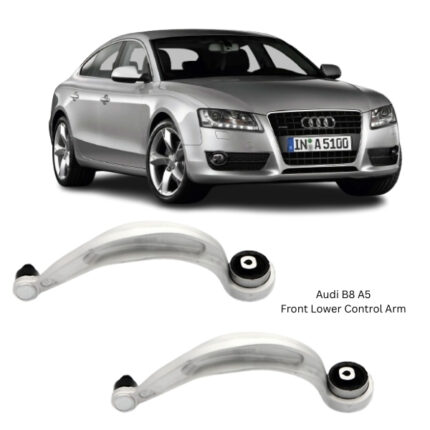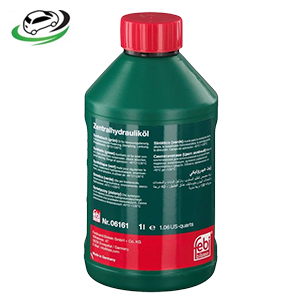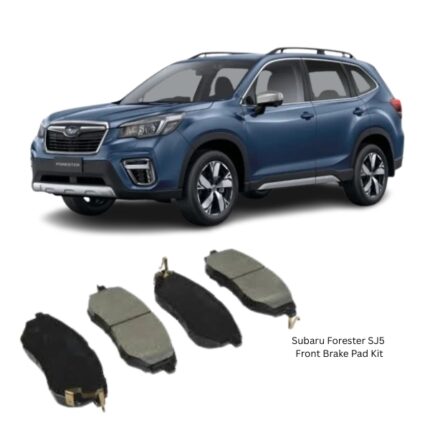Get Subaru Forester SJ5 Front Brake Pad Kit D7060 in Kenya
The Front Brake Pad Kit is a precision-engineered set of friction components designed to ensure consistent braking performance, optimal safety, and long-lasting durability for the front axle braking system of a vehicle. As one of the most crucial elements in any automotive braking system, the front brake pads are responsible for converting kinetic energy into heat energy through friction, enabling the vehicle to slow down or come to a complete stop with control and stability.
This kit typically contains a matched set of brake pads for both sides of the front axle, along with any necessary accessories such as shims, clips, and wear sensors. Every component is carefully designed to meet or exceed the original manufacturing standards, ensuring compatibility, ease of installation, and dependable performance under a wide range of driving conditions.
Function and Importance
Front brake pads work in conjunction with brake discs (rotors) to create the friction needed to slow a vehicle. When the brake pedal is pressed, hydraulic pressure from the master cylinder forces the caliper pistons to press the pads against the spinning disc. The friction surface of the pads is specially formulated to offer a balance between stopping power, heat dissipation, noise reduction, and pad life.
Given that the front brakes handle a significant portion of braking force—often more than 60%—the condition and quality of front brake pads are critical for safe driving. The Front Brake Pad Kit ensures that both sides of the front axle have uniform, high-quality friction material, preventing uneven braking and maintaining vehicle stability.
Key Components of the Kit
-
Brake Pads (Inner and Outer)
-
A complete set for both the left and right front wheels.
-
Typically includes four pads—two inner pads and two outer pads—engineered to match the caliper design.
-
-
Anti-Rattle Clips and Shims
-
Metal or composite components that reduce vibration, eliminate noise, and ensure proper pad alignment within the caliper.
-
-
Wear Indicators or Sensors
-
Depending on the design, these can be mechanical tabs or electronic sensors that signal when pad material is nearing the end of its service life.
-
-
Lubricant Pack
-
Some kits include high-temperature brake grease for lubricating sliding contact points, ensuring smooth pad movement and preventing binding.
-
Construction and Materials
The performance of front brake pads largely depends on the composition of their friction material. This is bonded to a robust backing plate that transfers braking forces to the caliper. Common material types include:
-
Semi-Metallic Pads
-
Contain a mixture of metals such as steel, iron, and copper, combined with friction modifiers and fillers.
-
Offer excellent heat resistance and durability, ideal for heavier vehicles or high-performance applications.
-
-
Ceramic Pads
-
Made from ceramic fibers, nonferrous filler materials, and bonding agents.
-
Provide smooth, quiet operation, minimal dust generation, and consistent braking performance across a wide temperature range.
-
-
Low-Metallic NAO (Non-Asbestos Organic)
-
Primarily organic materials with small amounts of metal for improved braking.
-
Good cold performance but may produce slightly more noise and dust compared to ceramic pads.
-
Performance Characteristics
When selecting a front brake pad kit, the following performance factors are typically considered:
-
Friction Coefficient
-
Indicates how much stopping power the pad can produce at a given pedal force.
-
-
Fade Resistance
-
The ability to maintain braking efficiency at high temperatures, preventing loss of stopping power during prolonged braking.
-
-
Noise Reduction
-
Shims, chamfers, and friction formulations help minimize squealing or grinding sounds.
-
-
Dust Control
-
The best brake pads generate minimal brake dust, keeping wheels cleaner.
-
-
Longevity
-
Quality pads are engineered to withstand wear over many thousands of kilometers, balancing pad life with rotor preservation.
-
Installation Considerations
Installing a front brake pad kit requires proper tools, safety precautions, and a basic understanding of the braking system. While many skilled vehicle owners may perform the replacement themselves, professional installation is often recommended to ensure the following:
-
Correct seating of pads within the caliper.
-
Proper application of lubricant to avoid sticking or binding.
-
Correct torqueing of caliper bolts.
-
Bedding-in process for optimal pad-to-rotor contact.
The bedding-in process involves performing a series of moderate stops to evenly transfer friction material onto the rotor surface, which enhances braking performance and reduces the risk of uneven wear.
Maintenance and Lifespan
The service life of front brake pads depends on driving style, road conditions, and vehicle weight. Urban driving with frequent stops tends to wear pads faster than highway cruising. Signs that front brake pads may need replacing include:
-
A squealing or screeching noise when braking.
-
Increased stopping distance.
-
A grinding noise (indicating the pad material is worn through to the backing plate).
-
Brake warning light illuminated (on vehicles with electronic wear sensors).
-
Visual inspection showing thin friction material (less than 3mm).
Routine inspections every 10,000 to 15,000 kilometers can help ensure timely replacement before performance or safety is compromised.
Advantages of Using a Complete Kit
-
Consistency: All pads are manufactured to the same specifications, ensuring balanced braking.
-
Convenience: No need to source individual components separately.
-
Safety: Properly matched pads reduce the risk of brake pull or uneven wear.
-
Noise and Vibration Control: Included shims and clips help maintain quiet, smooth operation.
-
Improved Performance: Fresh pads restore original braking efficiency and responsiveness.
Environmental and Safety Standards
Modern brake pads are designed to meet strict environmental regulations, such as reduced copper content, to minimize pollution from brake dust. Many kits also comply with internationally recognized safety standards, including ISO and SAE specifications, ensuring reliable performance in diverse conditions.
Storage and Handling
If not installed immediately, store the brake pad kit in a cool, dry environment, away from direct sunlight and moisture. Keep all components in their original packaging until use to avoid contamination with oils, grease, or dirt, which can affect friction performance.
Follow us on Facebook for more parts.




